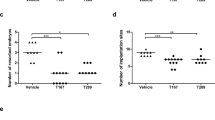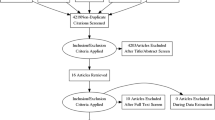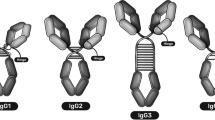Abstract
We report a case of severe fetal anemia associated with maternal anti-M antibody that was treated by direct injection of pooled human immunoglobulin into the fetal abdominal cavity. Four treatments at a dosage of 2 g per-kg estimated fetal body weight were performed, and no side effects were observed. A healthy baby girl was delivered transvaginally at 38 weeks, with neither exchange transfusion nor phototherapy required. Follow-up over 12 months found no indications of anemia or developmental delay in the child. This is believed to be the first report of fetal anemia in a blood-type-incompatible pregnancy being treated successfully with only direct immunoglobulin injection into the fetus. The immunoglobulin may have functioned as a neutralizing antibody causing the anemia to improve.
Similar content being viewed by others
Introduction
Trans-venous immunoglobulin injection (IVIG) to the mother and fetal transfusion are the commonly used treatments for fetal anemia in isoimmune hemolytic diseases of the fetus and newborn (HDFN). IVIG to the mother is advocated as an indirect fetal treatment option for neutralizing maternal red-cell alloimmunization,1 but several problems exist: the mother needs to be injected with large amounts of immunoglobulin on a frequent basis and the amount reaching the fetus cannot be measured, verified or guaranteed. To the best of our knowledge, no previous reports of cases in which fetal anti-anemic therapy with IVIG to the mother was completed with neither fetal-blood transfusion nor maternal-plasma exchange have been published. In this case, severe fetal anemia associated with maternal anti-M antibody2 was treated with immunoglobulin injected into the fetal abdominal cavity (IFAC) without postnatal phototherapy or plasma exchange.
Case
The mother was 22 years old (gravida 1; para 0) with no history of transfusion; she consented to this study. Maternal blood type was O/RhD positive and paternal blood type unknown.
Anti-M antibody was detected at 16-weeks gestation. Serological investigations used polyethylene glycol-gel and enzyme-tube methods. The antibody identification was performed with a commercially available panel (Ortho Clinical Diagnostics, Raritan, NJ, USA). The indirect anti-globulin test (gel method) was performed according to the manufacturer's instructions. The direct anti-globulin test (DAT) was performed after elution in gel cards containing AHG (anti-human globulin) or anti-IgG, anti-IgM, or anti-IgA and anti-C3b or anti-C3d, in separate wells. Both indirect anti-globulin test and DAT were performed with commercially available reagents (Ortho Clinical Diagnostics; Sysmex, Tokyo, Japan). A summary of results for the tests on the mother and on the fetus/infant is shown in Table 1.
The DAT was positive for IgG (Table 1). The mother was confirmed to be M antigen negative. Antibody titer was 1024 in the indirect anti-globulin test, with subsequent tests performed every 4 weeks showing continued high antibody titer. Middle cerebral artery peak systolic velocity was acutely elevated to 83.8 cm s−1 (1.6 MoM) at 30 weeks, and fetal anemia was confirmed using cordocentesis. The umbilical venous hemoglobin level was 6.4 g per 100 ml, the hematocrit level 17.9%, and the DAT results positive. Immunoglobulin (Venoglobulin IH, Benesis, Tokyo, Japan) was administered via direct immunoglobulin injection into the fetal abdominal cavity (IFAC) at a dosage of 2 g per-kg estimated fetal body weight using a 25-gauge needle.
No side effects were observed during and after IFAC. After 1 week, the hemoglobin level increased to 7.3 g per 100 ml. Three more IFAC treatments were carried out and ultrasonography showed complete absorption of the injected immunoglobulin within 3 days. At week 36, hemoglobin and hematocrit levels were 11.5 g per 100 ml and 33.9%, respectively; fetal status was closely monitored and showed reassuringly steady improvement. Further, IFAC treatment was therefore deemed unnecessary and discontinued.
A baby girl weighing 2605 g was delivered transvaginally at 38-weeks gestation. Apgar scores were 9/10 at 1/5 min, respectively. Following birth, the baby was screened and found to be M antigen positive and DAT negative; her blood type was O/RhD positive. As the mother was primigravida without a prior history of transfusion, and the newborn infant tested positive for M antigen, it was inferred that the HDFN was pregnancy induced. Infant hemoglobin and hematocrit levels immediately after birth were 15.1 g per 100 ml and 41.2%, respectively; infant DAT results were positive on day 0 and negative on day 6 (Table 1). On day 4, the hemoglobin level was 16.1 g per 100 ml and hematocrit level was 41.2%, total bilirubin was 17.5 mg per 100 mldl. Neither exchange transfusion nor phototherapy was required. Mother and infant were discharged on Day 6; follow-up over 16 months found no sequel or developmental delay.
An unexpected phenomenon, the disappearance of maternal anti-M antibodies (Table 1) during the course of the pregnancy was observed. From this we speculated that IgGs from IFAC, which may have transferred from the fetal to the maternal circulation, may have had a role as in antibody neutralization.
Discussion
We believe this to be the first report of isoimmune HDFN being treated successfully with IFAC (direct immunoglobulin injection into the fetal abdominal cavity), without fetal blood transfusion, postnatal phototherapy or plasma exchange.
Maternal anti-D immunoglobulin administration has been established as a treatment to prevent isoimmunization in Rh-D HDFN, but there are currently no clear treatment guidelines for minor blood-group type incompatibility. Such pregnancies are frequently managed in a similar manner to Rh-D incompatible pregnancies,1 and severe fetal hemolytic disease associated with anti-M maternal immunization has been reported.2 Fetal/neonatal complications from anti-M antibodies are thought to be extremely rare, even when the fetus is clearly M positive, and the great majority of pregnant women found to have anti-M antibody do not require cordocentesis or fetal IVIG administration. However, anti-M antibodies can cause fetal hydrops as reported,2 and the incidence of MN incompatibilities in the Japanese population seems to be higher than predicted.3
Some proposed mechanisms by which IVIG may reduce HDFN in fetuses and newborns are: (1) functions as a neutralizing antibody; (2) prevents antibody-combined cell destruction by blocking Fc receptors in the reticuloendothelial system; (3) aids deposition of the immune complex; (4) increases suppressor T-cells; and (5) decreases killer cells and peripheral lymphocytes.4, 5, 6
Reports indicate that in IVIG to the mother, the treatment is expensive because the mother needs to be injected with large amounts of immunoglobulin to neutralize all the alloimmune antibodies within the maternal circulation.4, 6 Moreover, although an amount of immunoglobulin administered via IVIG could exert positive effects on the fetus, whether or not specific amounts of immunoglobulin reach the fetus through the mother in IVIG cannot yet be verified, measured or guaranteed. In IFAC, however, the injection is targeted directly into the fetal abdominal cavity and the amount of immunoglobulin injected is very low. Accordingly, the procedure is inexpensive and the risk of side effects to the mother is very low.
Immunoglobulin administration for pregnant women is classified as ‘Category C’ (Risk cannot be ruled out) by the United States Food and Drug Administration (FDA) (http://www.fda.gov). Immunoglobulin intravenous (IGIV) products have been reported to be associated with such side effects as renal dysfunction, acute renal failure, osmotic nephrosis, acute hemolysis7, 8and death. However, most of the adverse effects associated with IVIG are mild and transient, and it is generally considered to be a safe therapy.9 Although in IFAC some immunoglobulin may transfer from the fetus into the maternal circulation through the placenta, the amount is presumed to be far too low to exert any side effects on the mother.
In the fetus, renal function is generally assessed by measuring bladder and amniotic volume using ultrasound, or more precisely measured using cordocentesis. In this case, the fetus had already developed hydrops fetalis (severe cardiac failure due to severe anemia), and we therefore assessed the fetal status using cordocentesis (fetal creatinine, fetal blood urea nitrogen, fetal bilirubin and so on.), cardiotocogram (CTG) and Doppler ultrasound. Neither fetal renal dysfunction nor deterioration of hemolysis was observed during the fetal therapy.
Although maternal IVIG is used in HDFN in addition to maternal/infant-plasma exchange and/or fetal transfusion, no favorable outcomes have been reported for IVIG used alone without fetal transfusion.10 IVIG can dilute pathogenic antibodies transferring from the mother to the fetus, but the effect cannot be guaranteed and the fetus continues sending alloimmune antigens to the mother. In contrast, IFAC may function as a fundamental defense against the attack of maternal alloimmune antibodies on the fetal side.
Both intra-abdominal and percutaneous cordocentesis, fetal-blood transfusion present technical risks and risks of infection. Reports have been made of cordocentesis procedure-related complication rates of up to 3.1%, resulting in an overall procedure-related fetal loss rate of 1.6%.11 However, IFAC presents less technical risk and lower cost than fetal-blood transfusion.12, 13 The safety of immunoglobulin for the fetus is presumed for the following reasons: (1) pooled human immunoglobulin is a heated, filtrated formula, and is therefore assumed to be safer than blood transfusion with respect to infection; (2) use of immunoglobulin in the treatment of HDFN has been established in pediatrics; and (3) immunoglobulin is also used in the treatment of neonatal hematological diseases related to the proposed mechanisms by which IVIG may reduce HDFN in fetuses and newborns, including immune platelet disorders (neonatal alloimmune thrombocytopenia, postransfusion purpura and so on.); bleeding disorders (acquired von Willebrand syndrome and so on.); and other disorders such as parvovirus B19-infected red-cell aplasia.14, 15 IFAC can also prevent a direct burden on the cardiac system in a fetus suffering hydrops fetalis, and has already been used to treat fetal cytomegalovirus infection and parvovirus B19 infection.12, 13
In this case, the amount of immunoglobulin injected into the fetus (2 g kg−1), the maximum dosage, was calculated on the basis of neonatal treatment of Kawasaki disease.16 However, the actual dosage that circulated in the fetus’s system is presumed to have been lower than 2 g kg−1, because in IFAC the immunoglobulin is injected directly into the fetal abdominal cavity and not directly into the fetal venous system. As fetal circulation comprises both the fetus and the placenta, the dosage of injected immunoglobulin could be diluted by the blood in the placenta and surplus immunoglobulin could be absorbed by the maternal circulation through the placenta. Thus, an ‘immunoglobulin overdose’ is potentially impossible when IFAC is used.
Conclusion
In this case IFAC (immunoglobulin injection into the fetal abdominal cavity) was successfully used alone, without postnatal phototherapy or plasma exchange to treat fetal hydrops caused by anemia because of pregnancy-induced anti-M antibodies causing fetal hemolysis. Although more reported cases of IFAC therapy are required to establish its efficacy, this procedure seems to be a promising treatment option for HDFN because of its safety, low cost and effectiveness as a direct symptomatic treatment.
References
The American College of Obstetricians and Gynecologists Practice Bulletin No. 75 Management of alloimmunization. Obstet Gynecol 2006; 108: 457.
Wilkman A, Edner A, Gryfelt G, Jonsson B, Henter JI . Fetal hemolytic anemia and intrauterine death caused by anti-M immunization. Transfusion 2007; 47 (5): 911–917.
Serizawa M, Matsui H, Oishi A, Maeda T, Sudoko K, Ohashi T et al. A case of hydrops fetalis caused by MN blood group incompatibility. Jpn J Obstetr Gynecol Neonatal Hematol 1999; 8: 145–152.
NIH Consensus Conference. Intravenous Immunoglobulin: Prevention and Treatment of Disease. J Am Med Assoc 1990; 264: 3189–3193.
Kaneko Y, Nimmerjahn F, Ravetch JV . Anti-inflammatory activity of immunoglobulin G resulting from Fc sialylation. Science 2006; 313 (5787): 670–673.
Nimmerjahn F, Ravetch JV . Anti-inflammatory activity of intravenous immunoglobulin. Annu Rev Immunol 2008; 26: 513–533.
Kahwaji J, Barker E, Pepkowitz S, Klapper E, Villicana R, Peng A et al. Acute hemolysis after high-dose intravenous immunoglobulin therapy in highly HLA sensitized patients. Clin J Am Soc Nephrol 2009; 4: 1993–1997.
Orbach H, Katz U, Sherer Y, Shoenfield Y . Intravenous immunoglobulin: adverse effects and safe administration. Clin Rev Allergy Immunol 2005; 29 (3): 173–184.
Orange JS, Hossny EM, Weiler CR, Ballow M; Berger M, Bonilla FA et al. Use of intravenous immunoglobulin in human disease: A review of evidence by members of the Primary Immunodeficiency Committee of the American Academy of Allergy, Asthma and Immunology. J Allergy Clin Immunol 2006; 117 (4 Suppl): S525–S553.
Porter TF, Silver RM, Jackson GM, Branch DW, Scott JR . Intravenous immune globulin in the management of severe Rh D hemolytic disease. Obstet and Gynecol Survey 1997; 52 (3): 193–197.
Van Kamp IL, Klumper FJ, Oepkes D, Meerman RH, Scherjon SA, Vandenbussche FP et al. Complications of intrauterine intravascular transfusion for fetal anemia due to maternal red-cell alloimmunization. Am J Obstet Gynecol 2005; 192 (1): 171–177.
Matsuda H, Kawakami Y, Furuya K, Kikuchi Y . Intrauterine therapy for a cytomegalovirus infected symptomatic fetus. BJOG 2004; 111 (7): 756–757.
Matsuda H, Sakaguchi K, Shibasaki T, Takahashi H, Kawakami Y, Furuya K . Intrauterine therapy for parvovirus B19 infected symptomatic fetus using B19 IgG-rich high titer gammaglobulin. J Perinat Med 2005; 33: 561–563.
Aref K, Boctor FN, Pande S, Uehlinger J, Manning F, Eglowstein M et al. Successful perinatal management of hydrops fetalis due to hemolytic disease associated with Dmaternal phenotype. J Perinatology 2002; 22: 667–668.
Mundy CA . Intravenous immunoglobulin in the management of hemolytic disease of the newborn. Neonatal Netw 2005; 24 (6): 17–24.
Burns JC, Capparelli EV, Brown JA, Newburger JW, Glode MP . Intravenous gamma-globulin and retreatment in Kawasaki disease. Pediatr Infect Dis J 1998; 17: 1144.
Author information
Authors and Affiliations
Corresponding author
Ethics declarations
Competing interests
The authors declare no conflict of interest.
Rights and permissions
This work is licensed under the Creative Commons Attribution-NonCommercial-No Derivative Works 3.0 Unported License. To view a copy of this license, visit http://creativecommons.org/licenses/by-nc-nd/3.0/
About this article
Cite this article
Matsuda, H., Yoshida, M., Wakamatsu, H. et al. Fetal intraperitoneal injection of immunoglobulin diminishes alloimmune hemolysis. J Perinatol 31, 289–292 (2011). https://doi.org/10.1038/jp.2010.127
Received:
Revised:
Accepted:
Published:
Issue Date:
DOI: https://doi.org/10.1038/jp.2010.127
Keywords
This article is cited by
-
Anti-M Alloimmunization in Pregnancy: An Unusual Cause of Bad Obstetric History
The Journal of Obstetrics and Gynecology of India (2016)



